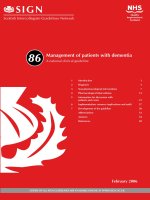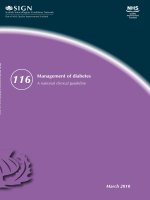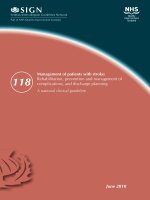Management of patients with dementia: A national clinical guideline docx
Bạn đang xem bản rút gọn của tài liệu. Xem và tải ngay bản đầy đủ của tài liệu tại đây (1.24 MB, 57 trang )
Management of patients with dementia
A national clinical guideline
1 Introduction 1
2 Diagnosis 3
3 Non-pharmacological interventions 7
4 Pharmacological interventions 13
5 Information for discussion with
patients and carers 21
6 Implementation, resource implications and audit 27
7 Development of the guideline 30
Abbreviations 33
Annexes 34
References 50
February 2006
86
COPIES OF ALL SIGN GUIDELINES ARE AVAILABLE ONLINE AT WWW.SIGN.AC.UK
86
Scottish Intercollegiate Guidelines Network
S I G N
KEY TO EVIDENCE STATEMENTS AND GRADES OF RECOMMENDATIONS
LEVELS OF EVIDENCE
1
++
High quality meta-analyses, systematic reviews of randomised controlled trials
(RCTs), or RCTs with a very low risk of bias
1
+
Well conducted meta-analyses, systematic reviews of RCTs, or RCTs with a low
risk of bias
1
-
Meta-analyses, systematic reviews of RCTs, or RCTs with a high risk of bias
2
++
High quality systematic reviews of case control or cohort studies
High quality case control or cohort studies with a very low risk of confounding or
bias and a high probability that the relationship is causal
2
+
Well conducted case control or cohort studies with a low risk of confounding or
bias and a moderate probability that the relationship is causal
2
-
Case control or cohort studies with a high risk of confounding or bias
andasignicantriskthattherelationshipisnotcausal
3 Non-analytic studies, eg case reports, case series
4 Expert opinion
GRADES OF RECOMMENDATION
Note: The grade of recommendation relates to the strength of the evidence on which the
recommendation is based. It does not reect the clinical importance of the recommendation.
A
At least one meta-analysis, systematic review of RCTs, or RCT rated as 1
++
and directly applicable to the target population; or
A body of evidence consisting principally of studies rated as 1
+
, directly applicable
to the target population, and demonstrating overall consistency of results
B
A body of evidence including studies rated as 2
++
, directly applicable to the target
population, and demonstrating overall consistency of results; or
Extrapolated evidence from studies rated as 1
++
or 1
+
C A body of evidence including studies rated as 2
+
, directly applicable to the target
population and demonstrating overall consistency of results; or
Extrapolated evidence from studies rated as 2
++
D Evidence level 3 or 4; or
Extrapolated evidence from studies rated as 2
+
GOOD PRACTICE POINTS
Recommended best practice based on the clinical experience of the guideline
development group
This document is produced from elemental chlorine-free material and is sourced from sustainable forests
©
Scottish Intercollegiate Guidelines Network
ISBN 1 899893 49 0
First published 2006
SIGN consents to the photocopying of this guideline for the purpose of implementation in NHSScotland
Scottish Intercollegiate Guidelines Network
28 Thistle Street, Edinburgh EH2 1EN
www.sign.ac.uk
11
1 INTRODUCTION
1 Introduction
1.1 THE NEED FOR A GUIDELINE
1
1.2 REMIT OF THE GUIDELINE
1.3 THE EVIDENCE BASE
1.4 DEFINITIONS
Dementia
Alzheimer’s disease
Vascular dementia
MANAGEMENT OF PATIENTS WITH DEMENTIA
Dementia with Lewy bodies
3
Fronto-temporal dementia
Mixed dementias
Creutzfeldt-Jakob disease
The
1.5 STATEMENT OF INTENT
1.6 REVIEW AND UPDATING
www.sign.ac.uk
3
++
++
++
1
++
+
++
2 Diagnosis
2.1 HISTORY TAKING AND DIFFERENTIAL DIAGNOSIS
see Annex 1
see
Annex 2
see Annex 3
see Annex 4
see Annex
5 see Annex 6
B DSM-IV or NINCDS-ADRDA criteria should be used for the diagnosis of Alzheimer’s
disease.
B The Hachinski Ischaemic Scale or NINDS-AIRENS criteria may be used to assist in
the diagnosis of vascular dementia.
C Diagnostic criteria for dementia with Lewy bodies and fronto-temporal dementia should
be considered in clinical assessment.
2 DIAGNOSIS
4
MANAGEMENT OF PATIENTS WITH DEMENTIA
++
++
++
2.2 INITIAL COGNITIVE TESTING
Annex 7
13
see Annex 7
B In individuals with suspected cognitive impairment, the MMSE should be used in the
diagnosis of dementia.
see Annex 8
2.3 SCREENING FOR COMORBID CONDITIONS
7
17
B As part of the assessment for suspected dementia, the presence of comorbid depression
should be considered
++
+
1
++
++
++
+
++
+
++
+
2.4 THE USE OF IMAGING
34
C Structural imaging should ideally form part of the diagnostic workup of patients with
suspected dementia.
C SPECT may be used in combination with CT to aid the differential diagnosis of dementia
when the diagnosis is in doubt.
2.5 THE ROLE OF CEREBROSPINAL FLUID AND ELECTROENCEPHALOGRAPHY
41
B CSF and EEG examinations are not recommended as routine investigations for
dementia.
2 DIAGNOSIS
MANAGEMENT OF PATIENTS WITH DEMENTIA
+
++
1
++
++
1
++
+
2.6 NEUROPSYCHOLOGICAL TESTING
44
B Neuropsychological testing should be used in the diagnosis of dementia, especially in
patients where dementia is not clinically obvious.
7
1
+
1
+
1
3 Non-pharmacological interventions
see Table 1
Table 1: Index to core and associated symptoms and non-pharmacological interventions
Core symptoms Section
Associated symptoms
Other
3.1 BEHAVIOUR MANAGEMENT
B Behaviour management may be used to reduce depression in people with dementia.
3 NON-PHARMACOLOGICAL INTERVENTIONS
MANAGEMENT OF PATIENTS WITH DEMENTIA
1
+
1
+
1
+
1
+
3.2 CAREGIVER INTERVENTION PROGRAMMES
B Caregivers should receive comprehensive training on interventions that are effective
for people with dementia.
3.3 COGNITIVE STIMULATION
B Cognitive stimulation should be offered to individuals with dementia.
3
1
3.4 ENVIRONMENTAL DESIGN
3.5 MULTISENSORY STIMULATION AND COMBINED THERAPIES
Melissa
ofcinalis
Lavendula ofcinalis
3 NON-PHARMACOLOGICAL INTERVENTIONS
MANAGEMENT OF PATIENTS WITH DEMENTIA
1
1
1
1
+
1
11
1
+
1
++
1
+
1
+
1
+
3.6 PHYSICAL ACTIVITIES
3.7 REALITY ORIENTATION THERAPY
D Reality orientation therapy should be used by a skilled practitioner, on an individualised
basis, with people who are disorientated in time, place and person.
3.8 RECREATIONAL ACTIVITIES
B Recreational activities should be introduced to people with dementia to enhance quality
of life and well-being.
3 NON-PHARMACOLOGICAL INTERVENTIONS
MANAGEMENT OF PATIENTS WITH DEMENTIA
1
1
1
+
3.9 SIMULATED PRESENCE
3.10 VALIDATION THERAPY
3.11 INTERVENTIONS LACKING EVIDENCE OF CLINICAL EFFECTIVENESS
13
1
++
4 Pharmacological interventions
Table 2: Index to core and associated symptoms and pharmacological interventions
Core symptoms Section
Associated symptoms
Other
4.1 CHOLINESTERASE INHIBITORS
1
4 PHARMACOLOGICAL INTERVENTIONS
14
MANAGEMENT OF PATIENTS WITH DEMENTIA
1
++
1
1
+
1
++
1
+
1
+
1
++
1
++
1
+
B Donepezil, at daily doses of 5 mg and above, can be used to treat cognitive decline in
people with Alzheimer’s disease.
B Donepezil, at daily doses of 5 mg and above, can be used for the management of
associated symptoms in people with Alzheimer’s disease.
B Galantamine, at daily doses of 16 mg and above, can be used to treat cognitive decline
in people with Alzheimer’s disease and people with mixed dementias.
113
B Galantamine, at daily doses of 16 mg and above, can be used for the management of
associated symptoms in people with Alzheimer’s disease.
1
++
1
++
1
+
1
+
1
++
1
+
1
++
1
+
117
B Rivastigmine, at daily doses of 6 mg and above, can be used to treat cognitive decline
in people with Alzheimer’s disease.
B Rivastigmine, at daily doses of 6 mg and above, can be used to treat cognitive decline
in people with dementia with Lewy bodies.
B Rivastigmine, at daily doses of 6 mg and above, can be used for the management of
associated symptoms in people with Alzheimer’s disease and dementia with Lewy
bodies.
4.2 MEMANTINE
4 PHARMACOLOGICAL INTERVENTIONS
MANAGEMENT OF PATIENTS WITH DEMENTIA
1
++
1
++
1
+
1
+
1
++
1
++
1
+
4.3 GINKGO
Ginkgo biloba
Ginkgo
Ginkgo biloba
Ginkgo biloba
Ginkgo
Ginkgo
Ginkgo
Ginkgo
Ginkgo
Ginkgo
Ginkgo
Ginkgo
Ginkgo biloba
4.4 SALVIA
Salvia ofcinalis
Salvia ofcinalis
Salvia ofcinalis
Salvia ofcinalis
Salvia ofcinalis
Salvia ofcinalis
17
1
+
1
+
1
+
1
++
4.5 ANTIDEPRESSANTS
137
137
137
D Antidepressants can be used for the treatment of comorbid depression in dementia
providing their use is evaluated carefully for each patient.
4.6 ANTIPSYCHOTICS
A If necessary, conventional antipsychotics may be used with caution, given their side
effectprole,totreattheassociatedsymptomsofdementia.
141
4 PHARMACOLOGICAL INTERVENTIONS
MANAGEMENT OF PATIENTS WITH DEMENTIA
1
++
1
++
1
++
1
+
++
143
144
4.7 TRAZODONE
4.8 CLINICALLY INEFFECTIVE INTERVENTIONS
147
A Anti-inammatoriesarenotrecommendedfortreatmentofcognitivedeclineinpeople
with AD.
B Hydroxychloroquine is not recommended for the treatment of associated symptoms
in people with dementia.
A Prednisolone is not recommended for the treatment of associated symptoms in people
with Alzheimer’s disease.
1
++
1
+
1
++
1
+
1
1
+
1
++
1
++
1
3
B Oestrogen is not recommended for the treatment of associated symptoms in women
with dementia.
A Selegiline is not recommended for the treatment of core or associated symptoms in
people with Alzheimer’s disease.
4.9 INTERVENTIONS LACKING EVIDENCE OF CLINICAL EFFECTIVENESS
A Valproate is not recommended for the treatment of behavioural symptoms associated
with dementia.
4 PHARMACOLOGICAL INTERVENTIONS
MANAGEMENT OF PATIENTS WITH DEMENTIA
1
++
171
+
4
+
+
+
+
5 Information for discussion with patients and
carers
5.1 SUPPORTIVE INFORMATION FOR PATIENTS AND CARERS
C Patients and carers should be offered information tailored to the patient’s perceived
needs.
173
C Healthcare professionals should be aware that many people with dementia can understand
their diagnosis, receive information and be involved in decision making.
C Healthcare professionals should be aware that some people with dementia may not wish
to know their diagnosis.
5 INFORMATION FOR DISCUSSION WITH PATIENTS AND CARERS
MANAGEMENT OF PATIENTS WITH DEMENTIA
4
3
173
D Healthcare professionals should be aware that in some situations disclosure of a diagnosis
of dementia may be inappropriate.
174
5.2 SOURCES OF FURTHER INFORMATION FOR PATIENTS AND CARERS
Alzheimer Scotland – Action on Dementia
Alzheimer’s Society
Alzheimer’s Research Trust
Pick’s Disease Support Group
Age Concern Scotland
Chest, Heart and Stroke Scotland
Help the Aged in Scotland
Mental Health Foundation Scotland
Dementia Services Development Centre
National CJD Surveillance Unit
5 INFORMATION FOR DISCUSSION WITH PATIENTS AND CARERS









